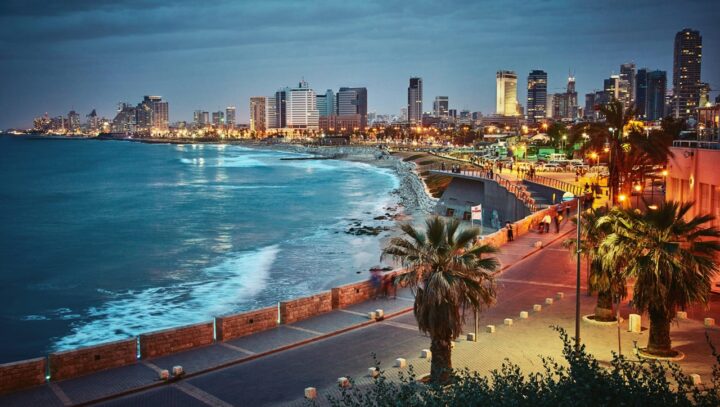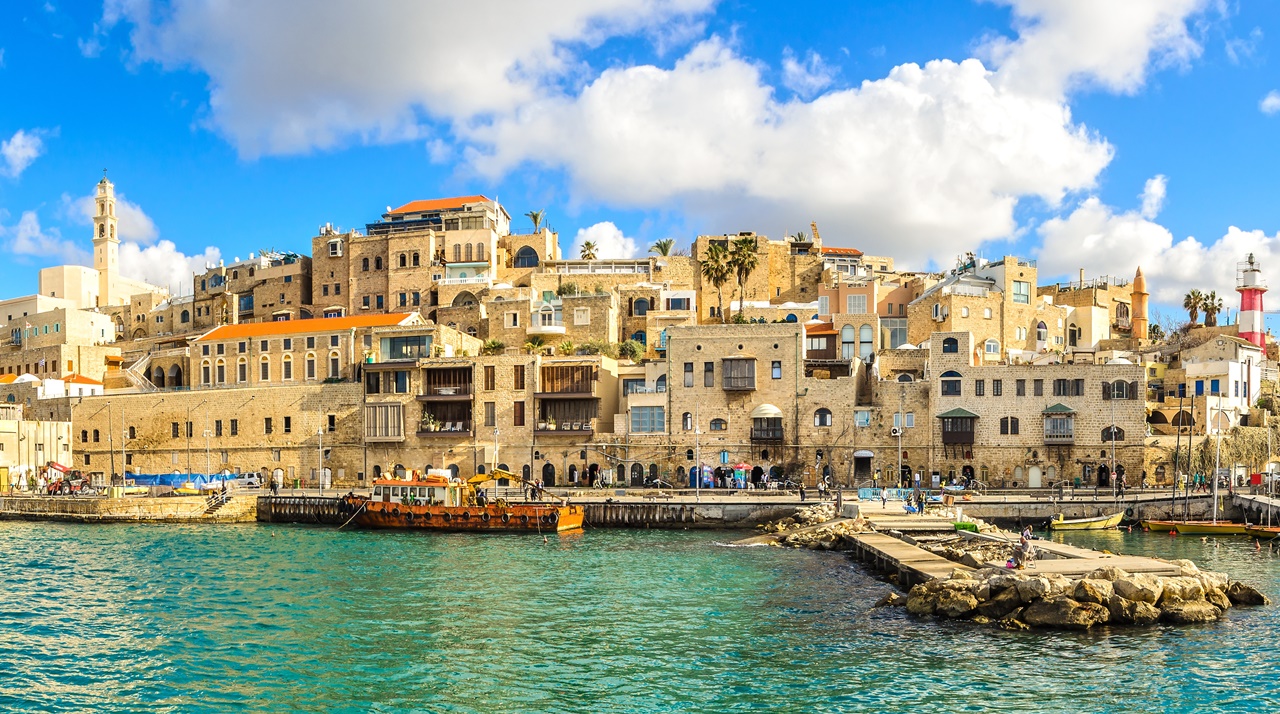
The 10 best things to do in Tel Aviv / Travel Guide
Tel Aviv enchants visitors not only with its beauty but also with its open-minded mentality. Find out here which sights you should definitely see in the “White City”!
As the second largest city in Israel and located directly on the Mediterranean Sea, Tel Aviv is a magnet for travelers who want to enjoy the Mediterranean flair and at the same time immerse themselves in the country’s way of life and history. Cosmopolitanism and multiculturalism can be found here as well as evidence of antiquity and modern Israeli art. Read on for 10 must-see attractions in the city that never sleeps!
1. The Old Port of Tel Aviv
Tel Aviv Port is popular with locals and tourists alike. In total, the city has three ports, the Old Port, the Marina and the Port of Jaffa. The old port is used as a leisure area and as a shopping mile. Here you can stroll comfortably or enjoy a meal in one of the restaurants with a view of the water. The harbor was in operation as such from 1938 to 1965, after which it rusted away until it was renovated and covered with handsome wooden planks in the 2000s. Many Jewish refugees arrived at this port, which at the time was an alternative to the Arab port of Jaffa. Locals not only use the Old Port to shop for fashion and sporting goods, but also visit the Farmers Market, a twice-weekly market that sells fresh farm produce.
2. Tel Aviv Museum of Art
The Tel Aviv Museum of Art is Israel’s largest art museum. Opened in 1932, it houses an impressive permanent exhibition as well as changing exhibitions showing the works of Israeli and international artists. Important works of Impressionism and Expressionism, Cubism, Constructivism and Surrealism can be found here. Joan Miró is represented as well as Monet, Renoir, Max Ernst, Max Liebermann, Cézanne, Pissarro and many other famous artists. The museum’s new wing, the Herta and Paul Amir building, opened in November 2011 and is a masterpiece in itself. It was designed under the direction of architect Preston Scott Cohen.
3. Palmach Museum
The Palmach Museum provides an exciting insight into the history of the Palmach, a paramilitary organization founded by the Jewish underground organization Haganah. The museum does not see itself as a typical museum with exhibits and documents, but tries to present itself in an innovative way. The visit is best planned in advance, as it is only possible as a guided tour. The 90-minute tour takes place in groups of up to 25 people and can be followed in English via headphones. However, children under the age of six cannot participate in the tour. Slide shows, films and photos including commentary show the historical events surrounding the Palmach and its veterans.
4. Neve Tzedek
In the last few decades, what is now the cultural district of Neve Tzedek has transformed itself from a slum into a popular shopping and trendy district. Built at the end of the 19th century as the first Jewish quarter outside of Jaffa, some of the 125-year-old houses can still be admired here today. Vacant lots were partly closed in an unconventional way, resulting in a varied architectural mix. Many artists have settled in Neve Tzedek and in addition to their galleries you can also browse designer shops and unusual fashion shops here. If you want to rest a bit in between, you will find many pretty cafés in this district where you can enjoy a delicious cappuccino, as well as stylish restaurants for larger appetites.
5. The Old City of Jaffa

Medieval alleys, artists’ studios and a beach promenade – Jaffa with its enchanting old town and its more than 5,000-year-old harbor invites you to take a long walk. A glimpse of Jaffa’s history can be had at the Old Jaffa Visitor Center at Kdumim Square, located on the hilltop of the old town. Here you can admire, among other things, Roman walls and other excavations, such as bowls from the Bronze Age and legacies from Roman times as well as everyday objects of the Jews who lived here in the 1930s. Other attractions in Jaffa include St. Peter’s Church, Immanuel’s Church and Simon the Garber’s House. The clock tower, where a flea market regularly takes place, can be found on the edge of the old town. If you are lucky enough to snag a bargain here, you should clarify in advance whether the item can also be exported.
6. Tayelet Promenade
“Tayelet” means “promenade” in Hebrew, so don’t be surprised if you come across Tayelets in Eilat or other coastal cities of Israel. Tel Aviv’s Tayelet stretches 14 kilometers along the Mediterranean coast, from Hatzok Beach in the north to Jaffa in the south. Tel Aviv’s beach promenade is also known from the 70s cult film “Popsicles”. However, the Tayelet has been renovated in recent years and since then the Tayelet promenade has been the ideal place for long walks by the sea. It is equipped with cycle paths and is also accessible for wheelchair users. Parks have been laid out along it, there is free Wi-Fi and numerous cafés and restaurants are located here. Skaters and joggers use the promenade, as do families and anglers.
7. Carmel Market (Shuk Ha’Carmel)
Carmel Market is located between Allenby Street and Nahalat Binyamin Street. Fragrant spices, exotic fruits and fresh vegetables – this is what the Carmel market attracts locals and travelers alike. Many small snack bars also offer fresh snacks and invite you to try the best hummus in Israel, stuffed bourekas and delicious falafel. Coffee lovers will also get their money’s worth at the Carmel Market: On the one hand, you can drink excellent milk coffee here, but on the other hand you can also enjoy a delicious espresso straight away. The market is open every day except Saturday, while hawkers selling handcrafted goods can also be found along Nahalat Binyamin Street on Tuesdays and Fridays.
8. Jarkon Afek National Park
The Jarkon Afek National Park is a popular local recreation area that enchants with the tranquility of nature and at the same time offers several sights: For example, you can admire the ruins of an old flour mill that was built in Roman times. Next to the Al-Mir Mill is a pond that was created artificially. Tel Aviv University is using this to reintroduce Acanthobrama telavivensis, a carp fish that was once common in Israel’s rivers but is now critically endangered. The ancient hilltop settlement of Tel Afek was also located here and was built on with an Ottoman fortress, the ruins of which can still be seen today.
9. Yitzchak Rabin Center
You can get a view of Yarkon Park from the Yitzchak Rabin Center. The research center is interesting as a building in itself: It was designed by the architect Moshe Safdie, who lives in Boston and Jerusalem and was involved in the redevelopment of the Old City of Jerusalem. The Yitzchak Rabin Center commemorates Israeli Prime Minister Yitzchak Rabin, who was assassinated in 1995 after a peace rally in Tel Aviv. A year earlier he had received the Nobel Peace Prize. The Yitzhak Rabin Center shows Yitzhak Rabin’s life story on the one hand and the history of Israel during his lifetime on the other. The center is north of Jarkon Afek Park and is best reached by public transport or car.
10. The hanging orange tree
A curiosity that no visitor to the city of Tel Aviv should miss is the Oranger Suspendu, the hanging orange tree. This is a sculpture hanging one meter above the ground: an orange tree has been planted in a huge natural stone seed. The sculpture was created by Ran Morin, an Israeli artist known for statues that incorporate living trees.
Categories: General
